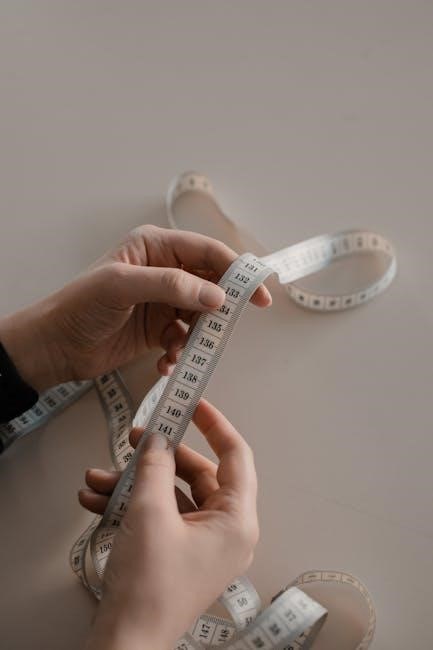Piriformis Stretch PDF: A Comprehensive Guide
Are you seeking relief from piriformis syndrome? This comprehensive guide, available as a downloadable PDF, provides detailed instructions on effective piriformis stretches․ Learn how to alleviate pain and improve hip mobility with our easy-to-follow techniques, enhancing your overall well-being and flexibility․
Piriformis syndrome is a neuromuscular condition characterized by pain, tingling, or numbness in the buttock and potentially radiating down the leg․ This occurs when the piriformis muscle, located deep in the buttock, irritates or compresses the sciatic nerve․ The sciatic nerve runs close to or even through the piriformis muscle, making it vulnerable to compression․ Understanding this relationship is crucial for effective management․
Symptoms of piriformis syndrome can mimic sciatica, making accurate diagnosis essential․ Individuals may experience pain that worsens with prolonged sitting, walking, or running․ Specific movements, such as internal rotation of the hip, can also exacerbate the pain․ This condition can significantly impact daily activities and quality of life․
This guide provides valuable information on piriformis stretches and exercises to help alleviate symptoms․ By understanding the causes and symptoms of piriformis syndrome, you can take proactive steps to manage the condition and improve your overall well-being․ The downloadable PDF offers a convenient resource for implementing these stretches and exercises into your routine, promoting long-term relief and improved function․
Understanding the Piriformis Muscle
The piriformis muscle is a small, but significant, muscle located deep in the buttock region, behind the gluteus maximus․ It originates from the sacrum (the triangular bone at the base of the spine) and inserts onto the greater trochanter of the femur (the large bony prominence on the upper thigh bone)․ Its primary function is to externally rotate the hip, allowing us to turn our leg outward․ It also contributes to hip abduction (moving the leg away from the midline) and hip stabilization․
The piriformis muscle’s close proximity to the sciatic nerve is what makes it a key player in piriformis syndrome․ In most individuals, the sciatic nerve passes underneath the piriformis muscle․ However, in some cases, the nerve may run through or even above the muscle, increasing the risk of compression and irritation․
Understanding the anatomy and function of the piriformis muscle is crucial for effectively addressing piriformis syndrome․ Stretches and exercises targeting this muscle can help release tension, reduce compression of the sciatic nerve, and alleviate pain․ This PDF guide provides detailed instructions on various stretches designed to target the piriformis muscle, promoting flexibility and reducing the risk of further irritation․ Regular stretching can contribute to long-term relief and improved hip function․
Common Causes of Piriformis Syndrome
Piriformis syndrome, characterized by buttock pain and potential sciatica, arises from various factors that irritate or compress the piriformis muscle․ One frequent cause is muscle overuse, often seen in athletes involved in activities like running, cycling, or rowing, which repetitively engage the hip rotators; This overuse can lead to muscle tightness, spasms, and inflammation, consequently impinging on the sciatic nerve․
Trauma to the buttock area, such as a fall or direct impact, can also trigger piriformis syndrome․ The resulting inflammation and muscle damage can compress the sciatic nerve, leading to pain and discomfort․ Anatomical variations, where the sciatic nerve passes through or above the piriformis muscle instead of underneath, predispose individuals to nerve compression and subsequent symptoms․
Prolonged sitting, especially with poor posture, can contribute to piriformis syndrome․ This posture can shorten the piriformis muscle, increasing pressure on the sciatic nerve․ Additionally, muscle imbalances, such as weak hip abductors or tight hip flexors, can alter hip mechanics and place excessive strain on the piriformis․ Understanding these common causes is essential for effective prevention and treatment․ This PDF guide offers targeted stretches to address muscle tightness and promote proper hip alignment, helping to alleviate piriformis syndrome symptoms․
Piriformis Stretch: Lying Supine Variation
The lying supine piriformis stretch is a gentle and effective method for relieving tension in the piriformis muscle․ Begin by lying on your back with both knees bent and feet flat on the floor․ Gently cross your right ankle over your left knee, creating a figure-four shape with your legs․ Reach your hands behind your left thigh and gently pull it towards your chest․
As you pull, you should feel a stretch in your right buttock, where the piriformis muscle is located․ It’s crucial to maintain a relaxed posture, keeping your shoulders and neck loose․ Avoid arching your lower back; instead, try to keep it pressed gently against the floor․ Hold this position for 20-30 seconds, breathing deeply and evenly throughout the stretch․
To deepen the stretch, you can gently use your right elbow to push your right knee away from your chest․ Be mindful not to force the stretch beyond your comfort level․ Repeat this stretch 2-3 times on each side, alternating between legs․ This variation is particularly beneficial as it allows for controlled and gradual stretching, minimizing the risk of injury․ Remember to consult our downloadable PDF for detailed illustrations and additional tips on performing this stretch correctly and safely․ This will help you maximize its benefits in relieving piriformis syndrome symptoms․
Piriformis Stretch: Seated Variation
The seated piriformis stretch is a convenient option for those who spend long hours sitting, providing a quick and effective way to release tension in the piriformis muscle․ Begin by sitting upright in a chair with your feet flat on the floor․ Cross your right leg over your left knee, placing your right foot on the outside of your left thigh․ Ensure your back remains straight throughout the stretch․
Gently twist your torso towards the right, using your left hand to apply pressure on your right knee, encouraging it to move further towards your chest․ You should feel a stretch deep in your right buttock․ Maintain a relaxed posture, avoiding any hunching or straining․ Hold this position for 20-30 seconds, breathing deeply and evenly․
To deepen the stretch, you can also gently lean forward from your hips while maintaining a straight back․ Be careful not to overstretch, and always listen to your body’s signals․ Repeat this stretch 2-3 times on each side, alternating between legs․ This variation is particularly useful as it can be performed almost anywhere, making it an ideal choice for office workers or those traveling․ Refer to our detailed PDF guide for visual aids and more tips to ensure you perform the seated piriformis stretch correctly and safely, maximizing its benefits for piriformis syndrome relief․
Piriformis Stretch: Pigeon Pose Variation
The Pigeon Pose, a popular yoga asana, offers an intense stretch for the piriformis muscle and surrounding hip rotators․ Start on your hands and knees․ Bring your right knee towards your right wrist, positioning your right ankle towards your left wrist․ The shin of your right leg should be as parallel to the front of your mat as is comfortable․
Slide your left leg straight back, ensuring your left thigh is rotated internally․ Lower your hips towards the floor, aiming for a square alignment․ If your right hip doesn’t comfortably reach the floor, use a folded blanket or cushion for support․ Inhale and lengthen your spine․ As you exhale, fold forward over your right leg, resting your forehead on the floor or a block․
Hold this position for 30-60 seconds, focusing on deep, even breaths․ Feel the stretch in your right buttock and hip․ To release, press back through your hands and return to your hands and knees․ Repeat on the left side․ This pose can be modified to suit different levels of flexibility․ For a deeper stretch, try actively pressing your hips towards the floor․ For a gentler stretch, keep your torso upright․ Our detailed PDF guide provides visual aids and modifications to ensure proper alignment and prevent injury, allowing you to safely and effectively utilize the Pigeon Pose for piriformis syndrome relief and improved hip flexibility․ Remember to listen to your body and avoid pushing beyond your comfortable range of motion․
Longsit Piriformis Stretch Technique
The Longsit Piriformis Stretch is a simple yet effective method to target the piriformis muscle and alleviate associated discomfort․ Begin by sitting on the floor with both legs extended straight out in front of you․ This is the “longsit” position․ Next, bend your right knee and cross your right foot over your left thigh, placing it as close to your left hip as comfortable․
Maintain a straight posture, avoiding slouching․ To deepen the stretch, gently twist your torso towards the right, using your left arm to hug your right knee or placing your left hand on the floor behind you for support․ Ensure that your back remains straight throughout the stretch to maximize its effectiveness and prevent strain․
You should feel a gentle to moderate stretch in your right buttock region․ Hold this position for approximately 20-30 seconds, breathing deeply and evenly․ Avoid bouncing or forcing the stretch․ Gradually release the twist and uncross your legs․ Repeat the same process on the left side, bending your left knee and crossing your left foot over your right thigh․ Perform the stretch on each side for 2-3 repetitions․
This longsit variation allows for controlled movement and provides a comfortable option for individuals with varying levels of flexibility․ Refer to our downloadable PDF guide for visual illustrations and detailed instructions to ensure correct form and maximize the benefits of this piriformis stretch․ Remember to consult with a healthcare professional if you experience any pain or discomfort during the exercise․
Iliopsoas Muscle Relation to Piriformis
The iliopsoas, a powerful hip flexor, plays a significant role in the function and potential dysfunction of the piriformis muscle․ Located deep within the abdomen and hip, the iliopsoas consists of the psoas major and iliacus muscles, which converge and attach to the femur․ Its primary function is to flex the hip and stabilize the spine․ However, tightness or imbalance in the iliopsoas can indirectly impact the piriformis․
When the iliopsoas is tight, it can contribute to anterior pelvic tilt, altering the alignment of the pelvis and lower spine․ This altered alignment can place increased stress on the hip joint and surrounding muscles, including the piriformis․ The piriformis muscle, responsible for external hip rotation, abduction, and stabilization, may become overworked and irritated as it attempts to compensate for the postural imbalances caused by a tight iliopsoas․
Furthermore, the iliopsoas and piriformis share a close anatomical relationship, both attaching to the hip bone․ A tight iliopsoas can compress nerves and blood vessels in the hip region, potentially exacerbating piriformis syndrome symptoms․ Therefore, addressing iliopsoas tightness is crucial for comprehensive management of piriformis-related pain and dysfunction․
Incorporating iliopsoas stretches into your routine can help restore balance to the hip and alleviate stress on the piriformis․ Refer to our downloadable PDF guide for effective iliopsoas stretches to complement your piriformis stretching exercises․ Regular stretching of both muscle groups can promote optimal hip function and reduce the risk of piriformis syndrome․ Remember to consult with a healthcare professional for personalized guidance and treatment․
Importance of Holding the Stretch
Holding a piriformis stretch for an adequate duration is crucial for achieving optimal therapeutic benefits․ When you stretch, you’re not just passively lengthening the muscle; you’re also influencing the nervous system and connective tissues surrounding it․ Holding the stretch allows the muscle fibers to gradually elongate, increasing flexibility and range of motion․
The initial phase of a stretch primarily involves the elastic component of the muscle․ However, sustained stretching encourages plastic deformation, which results in longer-lasting changes in muscle length․ This process requires time, typically around 20-30 seconds, for the muscle spindles to adapt and reduce the stretch reflex, allowing for deeper relaxation and elongation․
Moreover, holding the stretch facilitates increased blood flow to the piriformis muscle, promoting tissue healing and reducing inflammation․ The sustained tension encourages the release of muscle knots and adhesions, improving overall muscle function and reducing pain․ It also allows the nervous system to adapt to the new range of motion, reducing the likelihood of muscle guarding or spasms․
When performing piriformis stretches, aim to hold each stretch for at least 30 seconds, focusing on deep, diaphragmatic breathing to further enhance relaxation․ Avoid bouncing or jerking movements, as this can trigger the stretch reflex and potentially cause injury․ Consistency is key; regular stretching with appropriate hold times will gradually improve flexibility, reduce piriformis muscle tightness, and alleviate associated symptoms․ Refer to our PDF guide for detailed instructions on proper stretching techniques and recommended hold times․
Frequency and Repetitions for Optimal Results
Achieving optimal results from piriformis stretches requires a strategic approach to frequency and repetitions․ Consistency is paramount; incorporating these stretches into your routine regularly yields the best outcomes․ A general recommendation is to perform piriformis stretches at least 2-3 times per day, especially if you experience chronic tightness or pain; However, it’s crucial to listen to your body and adjust the frequency based on your individual needs and comfort level․
For each stretching session, aim to perform 2-3 repetitions of each piriformis stretch variation․ Holding each stretch for 30 seconds allows the muscle fibers to gradually elongate and relax․ Avoid overstretching or pushing through pain, as this can lead to injury․ Instead, focus on a gentle, sustained stretch that you can comfortably maintain․
When starting, begin with fewer repetitions and gradually increase the number as your flexibility improves․ It’s also beneficial to vary the stretches you perform to target different aspects of the piriformis muscle and surrounding tissues․ Combining lying supine, seated, and pigeon pose variations can provide a comprehensive approach to piriformis stretching․
Remember to maintain proper form throughout each stretch to maximize its effectiveness and minimize the risk of injury․ If you experience any sharp or persistent pain, discontinue the stretch and consult with a healthcare professional․ Our PDF guide provides detailed instructions and visual aids to ensure you perform each stretch correctly and safely․ Consistent practice, combined with proper technique, will help you achieve optimal results in relieving piriformis syndrome symptoms and improving hip mobility․
Other Exercises to Complement Piriformis Stretches
While piriformis stretches are crucial for alleviating piriformis syndrome, incorporating complementary exercises can enhance their effectiveness and promote overall hip health․ Strengthening the surrounding muscles, such as the glutes and hip abductors, provides stability and support, reducing strain on the piriformis․ Consider adding exercises like glute bridges, clamshells, and hip abduction exercises to your routine․
Core strengthening exercises are also beneficial, as a strong core helps maintain proper posture and alignment, minimizing stress on the lower back and hips․ Planks, bird dogs, and pelvic tilts can improve core stability and contribute to a more balanced musculoskeletal system․
Furthermore, addressing tightness in other areas of the body can indirectly alleviate piriformis syndrome symptoms․ Iliopsoas stretches, for example, can release tension in the hip flexors, which can often contribute to piriformis tightness․ Hamstring stretches are also important, as tight hamstrings can affect pelvic alignment and increase pressure on the piriformis muscle․
In addition to strengthening and stretching exercises, consider incorporating gentle cardiovascular activities, such as walking or swimming, to improve circulation and reduce inflammation․ These activities can also promote overall muscle relaxation and recovery․
Remember to listen to your body and gradually increase the intensity and duration of your exercises․ Consult with a physical therapist or other healthcare professional to develop a personalized exercise program that addresses your specific needs and limitations․ Combining piriformis stretches with complementary exercises will help you achieve comprehensive relief from piriformis syndrome and improve your overall hip function․
When to Consult a Professional
While self-care strategies like piriformis stretches can be effective for managing mild to moderate piriformis syndrome symptoms, there are situations where seeking professional medical advice is essential․ If your pain is severe, persistent, or worsening despite consistent stretching and home care, it’s time to consult a doctor or physical therapist․
Numbness, tingling, or radiating pain down your leg, especially if it extends below the knee, could indicate sciatic nerve involvement and requires professional evaluation․ These symptoms may suggest nerve compression or irritation that needs specific treatment․
If you experience a sudden onset of pain, particularly after an injury or trauma, it’s crucial to rule out other potential causes of your symptoms, such as a muscle tear, hip impingement, or spinal issue․ A healthcare professional can perform a thorough examination and order imaging tests, if necessary, to accurately diagnose your condition․
Additionally, if you have underlying medical conditions, such as arthritis, diabetes, or vascular problems, it’s wise to consult with your doctor before starting any new exercise or stretching program․ They can assess your individual risk factors and provide guidance tailored to your specific needs․
A physical therapist can provide a comprehensive evaluation, identify the root cause of your piriformis syndrome, and develop a personalized treatment plan that may include manual therapy, targeted exercises, and postural correction․ They can also teach you proper stretching techniques and help you progress safely and effectively․
Don’t hesitate to seek professional help if you’re unsure about the cause of your pain or if your symptoms are interfering with your daily activities․ Early diagnosis and treatment can prevent your condition from becoming chronic and improve your long-term outcome․




